|
|
|
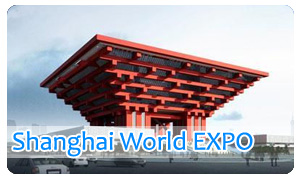 Brief
Introduction of 2010 Shanghai World EXPO Brief
Introduction of 2010 Shanghai World EXPO
World Expositions are the thoughts and also the galleries
of inspirations of humankind Shanghai Expo 2010 will
be a great event to investigate the full potential of
urban life in the 21st century and it is also a significant
period in urban evolution. The future of urban life
is a matter of global interest, and it concerns all
of the nations, no matter it is developed or undeveloped.
As the first World Exposition focusing on the theme
of city, 2010 Shanghai Exposition will attract governments
and people all over the world. During those days, the
participants of the world will display the overall affect
of urban civilization, exchange their experiences of
urban development, spread the advanced notions about
cities and human habitat, and explore new approaches
about the lifestyle and working conditions in the new
century. Moreover, they will learn how to create an
eco-friendly society and maintain the sustainable development
of human beings. Expo 2010 Shanghai will concentrate
on innovation and interaction.  Innovation
is the soul while cultural interaction is an important
mission of the World Expositions. In the new era, 2010
Shanghai Expo will contribute to human-centered development,
scientific and technological innovation, cultural diversity
and win-win cooperation for a better future, thus composing
a melody with the key and highlighting of innovation
and interaction in the new century. 2010 Shanghai Expo
will also be a grand international gathering. In addition,
2010 Shanghai Expo will offer a wonderful opportunity
for cross-culture dialogues. Innovation
is the soul while cultural interaction is an important
mission of the World Expositions. In the new era, 2010
Shanghai Expo will contribute to human-centered development,
scientific and technological innovation, cultural diversity
and win-win cooperation for a better future, thus composing
a melody with the key and highlighting of innovation
and interaction in the new century. 2010 Shanghai Expo
will also be a grand international gathering. In addition,
2010 Shanghai Expo will offer a wonderful opportunity
for cross-culture dialogues.
 Duration: Duration:
May 1st to Oct 31st, 2010
 Main
Districts: Main
Districts:
Both Sides of the Huangpu River, the Binjiang District
between Nanpu Bridge and Lupu Bridge
 Theme: Theme:
The theme of 2010 Shanghai Expo is "Better City,
Better Life," representing the common wish of all
the human beings for a better living in future urban
environments. And the theme also represents a central
concern of the international community for future policy
making, urban strategies and sustainable development.
 Sub-themes: Sub-themes:
☆ Blending of diverse cultures in the city
☆ Economic prosperity in the city
☆ Innovations of science and technology in the city
☆ Remodeling of communities in the city
☆ Interactions between urban and rural areas
 Main
Aims: Main
Aims:
☆ To raise public awareness of "urban age"
in the sense of the challenges and provide some possible
solutions;
☆ To promote the protection of urban heritage and make
people pay more attention to the health of urban development
☆ 3、To promote sustainable urban development concept,
successful practices and innovative technologies; search
for sustainable urban development patterns for developing
countries
☆ 4、to promote the exchange integration and mutual understanding
of human society
 Mascot: Mascot:
Hai Bao, based on the core originality of Chinese characters
of "人", not only reflects the characteristics
of Chinese culture, but also echoed the design ideas
of Shanghai World Expo emblem. To use the character
as the originality of the mascot initiatively in the
international and large-scale events is an innovation,
and Hai Bao is full of meaning from head to toe.
 Hair: Hair:
Like rolling waves, seems to be living and personality,
point out the regional features and life of the source
of the mascots Face: The simple cartoon facial expression
is full of friendliness and confidence.
 Eyes: Eyes:
Big and round eyes full of expectation for the future.
 Blue: Blue:
Full of inclusiveness, imagination, a symbol full of
hope and development potential of China.
 Body: Body:
Mellow body, demonstrating the good feelings of the
harmonious life, cute and witty.
 Fist: Fist:
Tilting thumb is praising and welcoming friends all
over the world.
 Big
foot: Big
foot:
Standing firmly on the ground has become the strong
support for the warm and open arms, indicating that
China has the ability and determination to run the World
Expo.
 Mouth: Mouth:
Always smiling, always issuing "Hey ~ Hey ~"
to invite the people from other countries.
 The
Core Idea: The
Core Idea:
City is a creation of man, and it continued to evolve
and grow as an organic system. Man is the most dynamic
and most innovative cells of the organic system. And
human's life is closely interacted with the form and
development of the city. With the acceleration of urbanization,
the city's organic system and the big earth's system
of interaction between the biosphere and resources are
also increasingly deeper and more expand. The three
organic systems, people, cities and the earth are spiraling
down, and this relationship run through the course of
urban development, they will also increasingly integrated
into an indivisible whole.
 Meaning
for Holding: Meaning
for Holding:
☆ It will be a great feast for exploring people's city
life in the new century.
☆ It will be a symphony based on the theme of "innovation"
and "integration".
☆ It will be a great gathering of the people from all
over the world.
☆ It will become a wonderful dialogue of human civilization.
|
| |
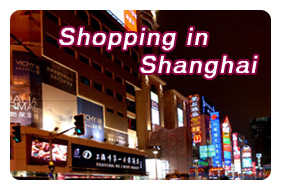 For
tourists, Shanghai is a world-famous "commercial
city", with the stores next to stores and eyeful
of goods to meet the needs of different levels at home
abroad. As the country's commercial center, its goods
are well known for good brand, high-quality, various kinds
and entire model. For
tourists, Shanghai is a world-famous "commercial
city", with the stores next to stores and eyeful
of goods to meet the needs of different levels at home
abroad. As the country's commercial center, its goods
are well known for good brand, high-quality, various kinds
and entire model.
Nanjing Road
Nanjing Road, the first business street of China, is length
of 5.5kms from north to south, with the entrance at bund
of Huangpu River, exits at Jing'an Temple. Nanjing Road
is the earliest commercial street after Shanghai opening
the port. Comply with the growing up of five global department
stores "Yongan", "Xianshi", "Xinxin",
"Daxin" and "Chinese Products", it
becomes the most bustling comprehensive commercial street
in Shanghai.
Huaihai Road
Huaihai road is called the France Champs, also as the
shopping paradise be equal to Nanjing Road.
Huaihai road, total length of about 6 km, was divided
into eastern, central and western three sections. The
most prosperous section is about 2.2 km length from Shangxi
road to Tibet road. Huaihai road used to be the French
concession, on both sides of wide, straight streets, planting
the London plane trees, in an extreme European style.
It has more then 400 shops, mainly selling middle and
high range products and attracting more than 1 million
persons per day. In addition, it's an eleg
ant and cultural street, the famous Sun Yat-sen's former
residence, Soong Ching Ling's former residence and Zhou
Residence are located on this street or adjacent to it.
Yuyuan Commercial City
Yuyuan commercial city is located at the Chenghuang temple
market which is at the south of Yuyuan Garden. Form the
year of 1991, the original Chenghuang temple market was
converted into a modern large-scale tourism and shopping
center - Yuyuan commercial city.
The road in the commercial city is narrow and most of
building built in before 1911, in an ancient Chinese architectural
style. The small shops distributed in the mall, merchandise
dazzling and bustling with customers, which maintains
the outlook of China's ancient cities and towns. It totally
has more than 50 stores with professional characteristics
and sell over 1200 kinds of commodities in commercial
city, certainly the "Commodity Kingdom". The
street of small commodity collects the traditional characteristics
shop, fully reflects the operating feature of "small,
local, unique, famous and superior". No matter Chinese
or foreigners tourists come to shanghai will have a visiting
at Yuyuan Commercial City.
Dongtai Road Antique Street
Dongtai Road Antique Street, located in the interchange
of Liuhe road and Dongtai road, is a specialty street
engaged in old crafts with high reputation at home and
abroad, also known as the "azure stone factory"
of Shanghai. The antique market main locates in the section
from Chongde road to Fuxing road.
At present, the market has more than 100 shops and most
of shops are small in shape. However, the decoration of
each shop is unique and in their own style. The major
commodities are old crafts, including porcelain, jade,
bronze, wood, calligraphy and painting, four treasures
of study and other miscellaneous pieces. Besides, there
are cages, clothing, coins, month card in thirty century,
fans, lighters, three inch golden lotus and so on.
New Shanghai Commercial City
New Shanghai Commercial City, with a total construction
area of 3.8 million square meters, is the comprehensive
business center integrated shopping, dining, tourism,
entertainment, leisure and other functions. It's located
in the middle of Lujiazui Finance and Trade Zone of Pudong,
east to Laoshan East road, south to Zhangyang road, west
to Pudong South road and north to Shangcheng road. The
center part is green square, outside is 600 meters walking
street with surrounded by 16 different styles of high
buildings. The size, facilities and functions of the commercial
city should be the first in Asia, and occupies the same
leading position with Nanjing road and the Bund.
It's total have 18 commercial buildings in New Shanghai
Commercial City, include No,1 Yaohan, Sanxin commercial
world, Huacheng commercial, Fuxing building and so on.
Now it has formed the four major trades in business, catering,
entertainment and finance; four major markets of operating
contents in general merchandise, computers, home appliances
and building materials; 15 catering industries composed
the food heaven. The daily average volume of commuters
reach 100 thousand and 200 thousand in weekend, with annual
sales revenue reach 2 billion yuan take up 10% of total
retail sales of Pudong district. |
| |
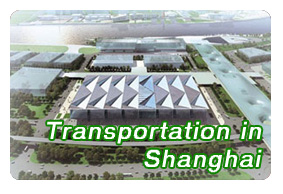 Getting
Around Shanghai Getting
Around Shanghai
Taxi 
Shanghai is served by a fleet of at least 45,000 taxis.
Visitors are advised that meter rates are significantly
higher than those in other cities.
Bus 
There are more than 1,100 bus routes in operation in
Shanghai, and buses are jam packed all day. Shanghai
Railway Station, Renmin Square (People's Square), Xujiahui,
Zhongshan Park, Wujiaochang, Shanghai Indoor Stadium
and Dongchang Road serve as the main bus transfer stations
in downtown Shanghai. Shenzhuang, Longyang Road and
Zhangjiang Hi-Tech Park stations provide many routes
to Shanghai's suburbs.
Fares for the regular public bus is RMB 1, and for air-conditioned
ones, RMB 2. Most bus routes accept the Shanghai Public
Transportation Card (IC card). Exceptions include some
of the Special and Suburban Lines.
Subway 
Shanghai has a comprehensive city rail transit system
known as the Metro, which combines subway, light rail
and the Pudong Airport Maglev line. There are 8 Metro
lines in all, with more under construction. Operation
hours for Lines 1- 4 are 6:00-22:30, and 6:00-22:00
for Line 5. The Metro system has introduced electronic
ticketing machines so visitors should carry plenty of
change. Fares range from RMB2 to RMB9 depending on distance.
Visitors staying in Shanghai for some time should purchase
a Shanghai Public Transportation Card, or IC card. The
card can be used on the Metro, on some public buses,
ferries, and even taxis. An IC card costs RMB 100 with
RMB 30 deposit and RMB 70 credit. Visitors can top up
the cards at any designated Metro station, bus station,
bank and store.
Maglev Train 
The Maglev Demonstration Line is the only commercial
train in the world that runs by magnetic levitation.
The train has no wheels: magnetic forces keep it hovering
a centimeter or so above the track, allowing very high
speeds. The line provides rapid transit from Pudong
International Airport to Longyang Road Metro Station-the
30-kilometer-long journey takes just eight minutes.
The train runs daily from 7:00 am until 9:00 pm.
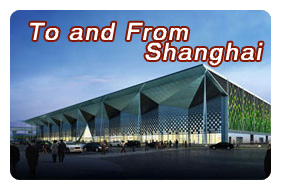
Bus 
Shanghai has about 1,680 long-distance bus routes that
connect it with many other cities in China. Most of
the bus stations concentrated around Zhabei District
near the Shanghai Railway Station. Popular destinations
include cities in Jiangsu and Zhejiang provinces.
Shanghai Long-Distance General Bus Station (Shanghai
Changtu Qiche) Zongzhan
Hutai Road Long-Distance Bus Station (Hutai Lu Qichezhan)
Shanghai Long-Distance General Bus Station (Shanghai
Changtu Qiche) Zongzhan
Hutai Road Long-Distance Bus Station (Hutai Lu Qichezhan)
Train 
Shanghai's busiest train stations are Shanghai Railway
Station and Shanghai South Railway Station.
Shanghai Railway Station (Shanghai Zhan)
This is located in Zhabei district, on the intersection
of Metro Lines 1, 3 and 4. At least 160 trains run daily
between Shanghai and other cities all over the country.
There are express trains to Beijing, Nanjing, Suzhou,
Hangzhou, Wuxi, Changzhou and Changsha. Shanghai Railway
Station also runs tourist trains to Huangshan and Yan'an,
while Shanghai South Railway Station runs a tourist
train to Wuyishan. Visitors are advised to reserve their
tickets 4-9 days in advance.
Shanghai South Railway Station (Shanghai Nanzhan)
Shanghai South Railway station serves southern destinations
like Hangzhou, Jiashan, and Hong Kong. There are also
express trains to Hangzhou (approximately 1.5 hrs),
Changsha (approximately 7.5 hrs) and Nanchang (approximately
5 hrs). The station is located at the intersection of
Metro Lines 1 and 3.
Tickets for trains departing this station and Shanghai
Railway Station are available nine days before the departure
date, and can be purchased at the railway station. Tickets
can also be purchased at ticket agencies and hotels
four days in advance of the departure date. Expect to
pay an additional RMB5 for processing.
Air 
Shanghai has two international airports, Pudong International
Airport (PVG) and Hongqiao International Airport (SHA).
Pudong International Airport serves as an international
gateway while Hongqiao handles domestic flights.
Shanghai Pudong International Airport (PVG) is approximately
30 kilometers outside the city center, while Hongqiao
International Airport is about 13 kilometers from Shanghai.
Pudong currently serves more than 50 airlines from home
and abroad that connect to more than 70 international
cities and 60 domestic destinations.
Domestic-international transfer travelers and vice versa
usually have to make their way from one airport to the
other to complete their journey. A shuttle service connects
the two airports, and the journey time is usually about
1 and a half hours.
Pudong International Airport (PVG)
Hongqiao International Airport (SHA)
Water
The Port of Shanghai mainly functions as a cargo port
these days, but it still serves some passenger routes.
Daily routes include Chengsi Island (Zhejiang Province),
Changxing Island, Chongming Island and Hengsha Island.
Visitors traveling to Chengshi Island should go to Luchao
Port. Passengers are advised to phone ahead, as weather
frequently disrupts schedules. Those bound for Changxing
Island, Chongming Island and Hengsha Island should head
for Wusong Passenger Transport Center and Wusong Port.
Ships travel to Putuoshan (Zhejiang), Sijiao (Zhejiang)
and Dinghai (Zhoushan City). Travelers heading to these
destinations should head for Gongpin Road Port. They
should arrive at the port at least half an hour before
departing. International destinations include Incheon
and Pusan in Korea and Osaka and Kobe in Japan. Ships
depart from Shanghai Port International Cruise Terminal.
|
| |
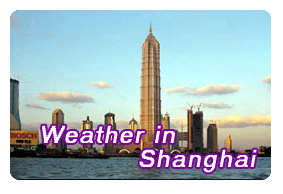 Shanghai,
the eighth largest city of the world is also the largest
city in China. The Shanghai weather plays an important
role in the lives of the locals. Shanghai has a humid
subtropical climate, which is heavily influenced by the
monsoons and experiences four distinct seasons. The average
temperature of Shanghai hovers at around 15.7 degrees
Celsius. Temperature varies widely from -10 degrees Celsius
to 41 degrees Celsius. Shanghai,
the eighth largest city of the world is also the largest
city in China. The Shanghai weather plays an important
role in the lives of the locals. Shanghai has a humid
subtropical climate, which is heavily influenced by the
monsoons and experiences four distinct seasons. The average
temperature of Shanghai hovers at around 15.7 degrees
Celsius. Temperature varies widely from -10 degrees Celsius
to 41 degrees Celsius.
The months of July and August are the hottest, recording
an average high of 32 degrees. In spite of being hot
and humid, summer is the peak season for tourism. Summers
experience torrential rain quite frequently.
In winter, cold northerly winds from Siberia can cause
nighttime temperatures to drop below freezing, and although
not usually associated with snow, the city can receive
one or two days of snowfall per year. In contrast, and
in spite of being the peak tourist season, summer in
Shanghai is very warm and humid, with occasional downpours
or freak thunderstorms. The city is also susceptible
to typhoons, none of which in recent years has caused
considerable damage. The most pleasant seasons are spring,
although changeable, and autumn, which is generally
sunny and dry. Shanghai experiences on average 1,878
hours of sunshine per year, with the hottest temperature
ever recorded at 40 °C (104 °F), and the lowest at ?12
°C (10 °F). The average number of rainy days is 112
per year, with the wettest month being June. The average
frost-free period is 276 days. Often during a year,
the city experiences a few spells of typhoon. The cyclone
inflicts a considerable amount of damage to the city.
|
|
|
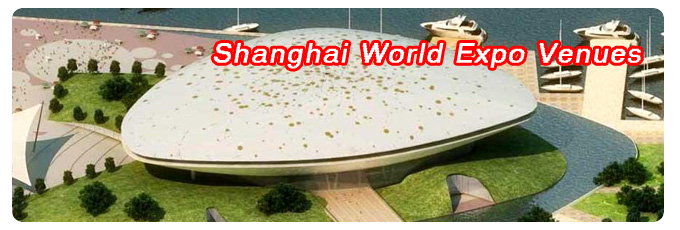
|
| Venues Distribution |
A Area:
China Pavilion
Foreign Pavilions (mainly the Asian countries, except
for Southeast Asia)
|
D Area:
Enterprise Pavilion
|
B Area:
Theme Pavilion
Some Pavilions of some countries in Southeast Asia
and Oceania
Pavilion of International Organizations
Public Activity Center
Performing Arts Center
|
E Area:
Enterprise Pavilion
Urban Civilization Pavilion
Best Practice Area of Urban
|
C Area:
Foreign Pavilions (countries of Europe, America
and Africa)
|
|
|
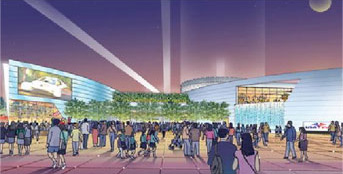 USA
Pavilion USA
Pavilion
The much-anticipated USA Pavilion for the upcoming World
Expo will feature a show entitled "The Garden"
- the story of a 10-year-old girl who envisages turning
a vacant city lot into an urban oasis, working with her
neighbors to make that happen. The pavilion will feature
live shows and multimedia in four performance spaces.
The one-hour program begins with the "Spirit of America,"
a video of classic American landscapes. The second section
will display videos showing US people greeting visitors
in Mandarin. "The Garden" will be the centerpiece
of the third part, while the last section will showcase
how US people have made their communities healthier, more
sustainable and culturally diversified.
|
| |
|
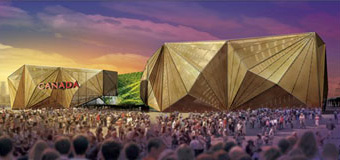 The
Canada Pavilion for Expo 2010 The
Canada Pavilion for Expo 2010
Shanghai China is designed in collaboration with Cirque
du Soleil, which will also create public performances,
organize cultural programs and develop strategic corporate
alliances for the pavilion. Cirque du Soleil was founded
by Guy Laliberte, a member of a street band from the
Province of Quebec in 1984. The 6,000-square-meter pavilion
is among the largest at the Expo site, will feature
an exhibition themed "The Living City: Inclusive,
Sustainable, Creative." The pavilion is about the
size of two-and-a-half NHL ice hockey rinks, it is expected
to welcome up to 5.5 million people or 30,000 visitors
per day during the six-month exposition period. An open
public place and three large geometric blocks will anchor
and surround the pavilion respectively. The square will
be a performing area, where visitors can watch the performances
of Cirque du Soleil before checking out the pavilion
Environmental protection ideas are being adopted into
the Canada Pavilion's design principle. Part of the
exterior walls will be covered by a special kind of
greenery and rainwater will be collected by a drainage
system for use inside the pavilion.
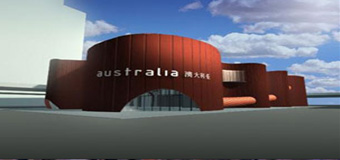 Australia
Pavilion - Mastering the Challenges Australia
Pavilion - Mastering the Challenges
"Mastering the challenges: Australia's smart solutions
for our urban future" is the exhibition theme for
the 4,800-square-meter Australia Pavilion. It resounds
the "Better City, Better Life" theme for Expo
2010 Shanghai China, and it demonstrates the country
"the Best Livable Place in the World" through
showcasing the solutions to future challenges in environmental
protection, urbanization and globalization, as well
as to demonstrate the beauty of Australia's natural
scenery. This is how the country to make urban sustainable
growth and achieve the harmony between city constructions
and natural environment. The exhibition contents of
the Australian pavilion include the healthy and vigorous
economy, the efforts made for sustainable economic development,
state of the art technology and innovative spirit. As
well as world's top higher educational institutions,
cultural diversity, beautiful scenery and high-quality
daily life. The Australia Pavilion is a very interesting
exhibition hall with excellent leisure programs. The
staffs who are fluent in Chinese and English will serve
as tour guides in the pavilion. Artists and musicians
will make spectacular performances and you can taste
Australian foods, red wine and soft drinks. Additionally,
Australian government will arrange business and cultural
exchange activities. During the 184-day World Expo in
Shanghai, Australia estimates that there will be 7 million
visitors to tour the pavilion.
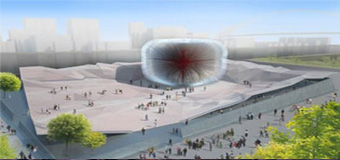 UK
Pavilion - the Pavilion of Ideas UK
Pavilion - the Pavilion of Ideas
The Pavilion of Ideas, designed by Heatherwick Studio,
is a brightly lit cube, which looks quite simple but
very fascinating. The highlight of the pavilion is that
its looks like a box with thousands of spines that hover
without visible support above the ground. The spines
have colored light sources on their tops, to which they
can form different patterns and images. "The image
can be changed every day or every week. If people love
to see David Beckham, we will play Beckham's picture.
If Louis Hamilton wins the F1 Championship, maybe we
will show Hamilton," said Carma Elliot, British
Consul-General in Shanghai. Elliot said the pavilion
would have unique effects in daytime, although it looks
like it will be much more beautiful at night. All the
spines will wave as the breeze blows. Meanwhile, the
spectators at the public square outside the UK Pavilion
can view the activity's information and images broadcasted
from inside. Audiences' interaction is important to
the UK Pavilion. It will gather the ideas and opinions
from the visitors and it will change the scheduled contents
and programs from time to time.
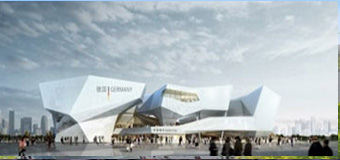 Germany
Pavilion, Int'l Expo Pavilions Germany
Pavilion, Int'l Expo Pavilions
"balancity" - a city in balance The German
Pavilion has been christened "balancity" -
a newly coined word signifying a city in balance. Visitors
to balancity will embark on a journey through a city
of ideas, moving around as they would in a real city
- on foot, moving walkways and escalators - through
thematic areas representing different urban spaces.
The journey starts at the harbor and leads through gardens
and parks, via a Town planning office and a factory
and past the opera to end at the "Energy Source",
the city's power plant. A city can be a good place to
live - if it provides a balance between renewal and
preservation, innovation and tradition, urbanity and
nature, community and individual development and work
and leisure. That's the message of the German Pavilion.
For more information on Germany Pavilion and its activities,
please logon www.expo2010-deutschland.de/en/
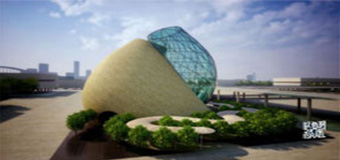 Israel
Pavilion - A Beautiful Seashell Israel
Pavilion - A Beautiful Seashell
"Innovation Makes Life Better" is the theme
of the Israel Pavilion for Expo 2010 Shanghai China.
It will demonstrate the long tradition of the Jewish
culture and the progressing of the Israeli people. Israel
will also attach importance in the similarities of Chinese
and Jewish cultural traditions. Innovation and future
are the essential elements of the seashell, which is,
in very correspondence, with the image of the lovely
"Haibao", the mascot of Expo 2010 Shanghai
China. Two streamlined constructions look like two hands
that hold together, which symbolizes Israel's technology
and innovation. The Israel Pavilion takes up an area
of 2,000 square meters. It divides into three experience
areas, Murmuring Garden, Hall of Light and Innovative
Hall. In the garden, you can make dialogue with the
Mother Nature by appreciating the beautiful scenery.
In the Hall of Light you can see the time tunnel of
Israel's long history and its development. You will
be facing the future challenge in the Innovative Hall,
which is climax of the expo tour that you will experience
the magnificent floating three-dimensional light ball.
The 360-degree audio and visual performance reveals
the innovation in every field of Israeli science and
technology, and some important achievements.
|
| |
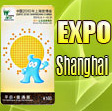 Types
of Tickets and Applicable Rules Types
of Tickets and Applicable Rules
about 2010 Shanghai EXPO |
|
|
|
Price and Illustration
Price
The standard price of the ticket for Shanghai EXPO is
160 Yuan. In order to balance the visitors flow rate,
fares will float according to different time and different
throng. For example, in order to diverse the visitors
during the day, there will be special night tickets
with the time of 5 hours. The main aim is to arouse
the attention of the local residents in Shanghai, and
encourage the people to avoid the peak during the day.
The price will be a little cheap at night relatively.
IIIustration
1. Peak Day:
May 1st-May 3rd, Oct 1st-Oct 7th, Oct 25th-Oct 31st,
2010; Total:17 days
2. Standard Day:
May 4th-Sep 30th, Oct 8th-Oct 24th, 2010 Total:
167 days
3. Free tickets:
For the children who is 1.2 meter or below
Sales Phases
The Expo tickets will be available for purchase either
during the Expo session or in advance, when tickets
are purchased in advance, there are 3 different pre-sale
phases available.
Pre-sale Phase I (Mar. 27, 2009 - Jun. 30, 2009): Purchase
is only available for groups as organizations, institutions
and enterprises, etc. Peak Day Single Day Admission
and Standard Day Single Day Admission tickets are available
during this phase.
Pre-sale Phase II (Jul. 1, 2009 - Dec. 31, 2009): Both
individual and groups are allowed to purchase Peak Day
Single Day Admission and Standard Day Single Day Admission
tickets during this phase.
Pre-sale Phase III (Jan. 1, 2010 - Apr. 30, 2010):
Both individual and groups are allowed to purchase Peak
Day Single Day Admission, Peak Day Special Admission,
Standard Day Single Day Admission, Standard Day Special
Admission, 3 Day Admission and 7 Day Admission tickets
during this phase.
Expo session sales (May 1, 2010 - Oct. 31, 2010): Both
individual and groups are allowed to purchase Peak Day
Single Day Admission, Peak Day Special Admission, Standard
Day Single Day Admission, Standard Day Special Admission,
3 Day Admission, 7 Day Admission and Evening Admission
tickets during this phase
|
| |
|



